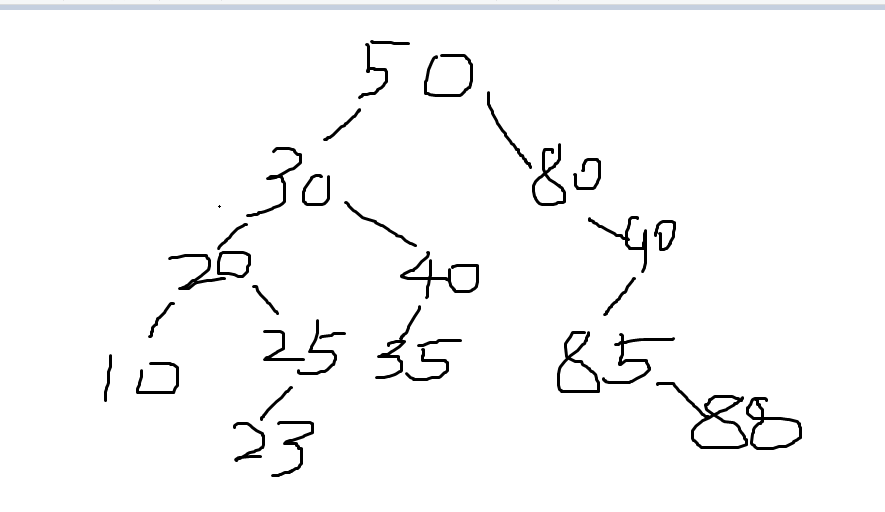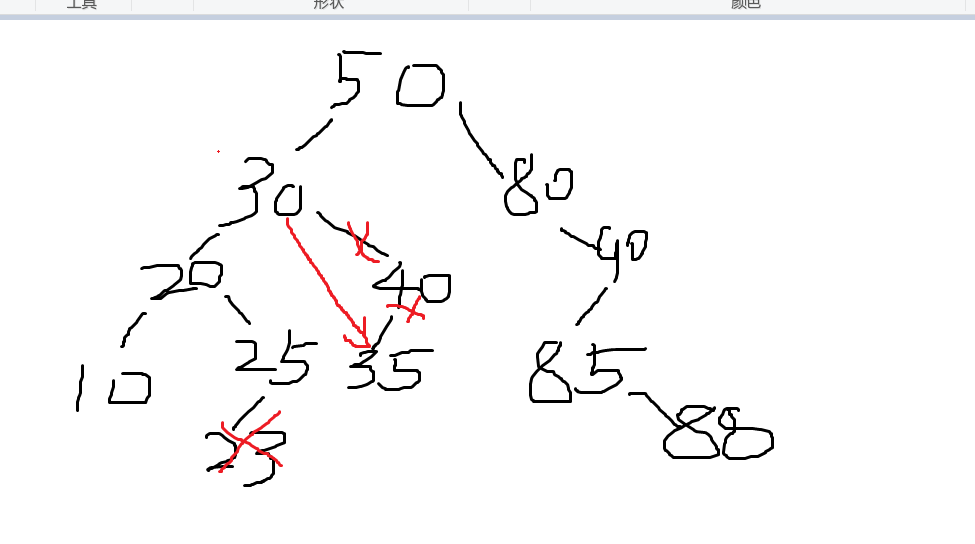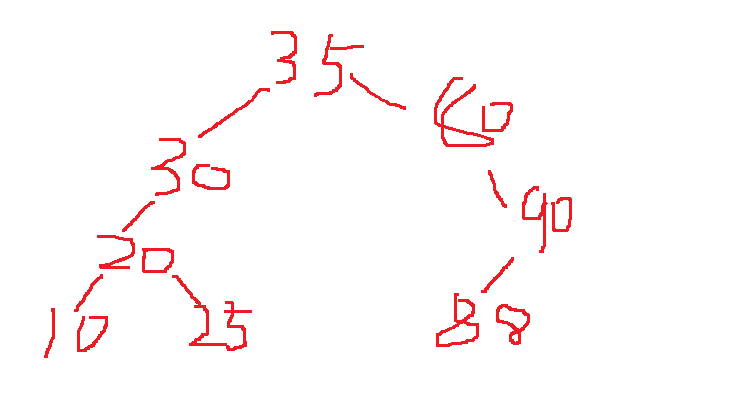二叉树的实现
一.二叉排序树的结点类型
typedef int KeyType;
typedef struct node
{ KeyType key; //关键字项
InfoType data; //其他数据域
struct node *lchild,*rchild; //左右孩子指针
} BSTNode;
二.SearchBST(BSTNode *T,KeyType k)
伪代码
BSTNode *SearchBST(T,k)
{
if (T为空 || T->key==k)
return T; //返回T,递归出口
if (k<T->key)
return SearchBST(T->lchild,k); //在左子树中递归查找
else
return SearchBST(T->rchild,k); //在右子树中递归查找
}
代码
BSTNode* SearchBST(BSTNode* T ,KeyType k)
{
if (T == NULL || T->key == k)
return T;
if (k < T->key)
return SearchBST(T->lchild,k);
else
return SearchBST(T->rchild,k);
}
三.InsertBST(BSTNode *&T,KeyType k)
伪代码
int InsertBST(T,k)
{
if (T为空) //原树为空, 新插入的记录为根结点
{ 创建一个新的key域为k的结点;
return 1;
}
else if (k==T->key) //存在相同关键字的结点,返回0
return 0;
else if (k<T->key)
return InsertBST(T->lchild,k); //插入到左子树中
else
return InsertBST(p->rchild,k); //插入到右子树中
}
代码
int InsertBST(BSTNode*& T,KeyType k)
{
if (T == NULL)
{
T = new BSTNode;
T->key = k;
T->lchild = T->rchild = NULL;
return 1;
}
else if (k == T->key)
return 0;
else if (k < T->key)
return InsertBST(T->lchild,k);
else
return InsertBST(T->rchild,k);
}
四.CreatBST(KeyType A[],int n)
伪代码
BSTNode *CreatBST(A[],n) //返回树根指针
{ BSTNode *T;
T为空树;
int i=0;
while (i<n)
{ InsertBST(T,A[i]); //将A[i]插入二叉排序树T中
i++;
}
return T; //返回建立的二叉排序树的根指针
}
代码
BSTNode* CreatBST(KeyType A[],int n)
{
BSTNode* T = NULL;
int i = 0;
while (i < n)
{
InsertBST(T,A[i]);
i++;
}
return T;
}

五.DeleteBST(BSTNode *&T,KeyType k)
伪代码
int DeleteBST(T,k) //在bt删除关键字为k的结点
{
if (T为空) return 0; //空树删除失败
else
{ if (k<T->key) return DeleteBST(T->lchild,k);
//递归在左子树中删除为k的结点
else if (k>T->key) return DeleteBST(T->rchild,k);
//递归在右子树中删除为k的结点
else
{ Delete(T); //调用Delete(T)函数删除*T结点
return 1;
}
}
}
void Delete(p) //从二叉排序树中删除*p结点
{ BSTNode *q;
if (p结点没有右子树)
{ 用其左孩子结点替换它
}
else if (p结点没有左子树)
{ 用其右孩子结点替换它
}
else Delete1(p,p->lchild);
//*p结点既没有左子树又没有右子树的情况
}
void Delete1(p,r)
//当被删*p结点有左右子树时的删除过程
{ BSTNode *q;
if (r的右孩子不为空)
Delete1(p,r->rchild); //递归找*r的最右下结点
else //r指向最右下结点
{
用r结点替换p;
删除r结点;
}
}
代码
int DeleteBST(BSTNode*& T,KeyType k)
{
if (T == NULL) return 0;
else
{
if (k < T->key)
return DeleteBST(T->lchild,k);
else if (k >T->key)
return DeleteBST(T->rchild,k);
else
{
Delete(T);
return 1;
}
}
}
void Delete(BSTNode*& p)
{
BSTNode* q;
if (p->rchild == NULL)
{
q = p; p = p->lchild;
free(q);
}
else if (p->lchild == NULL)
{
q = p; p = p->rchild;
free(q);
}
else Delete1(p,p->lchild);
}
void Delete1(BSTNode* p,BSTNode*& r)
{
BSTNode* q;
if (r->rchild != NULL)
Delete1(p,r->rchild);
else
{
p->key = r->key;
p->data = r->data;
q = r; r = r->lchild;
free(q);
}
}






六.
随机生成包含100000个节点的BST,节点的值为证书其范围为[-300000,300000],输出其树的高度。然后随机搜1000个数值,统计每次的ASL。
#include<iostream>
#include<cstdlib>
#include<ctime>
using namespace std;
typedef int KeyType;
typedef int InfoType;
typedef struct node
{
KeyType key; //关键字项
InfoType data; //其他数据域
struct node* lchild, * rchild; //左右孩子指针
} BSTNode;
BSTNode* SearchBST(BSTNode* T ,KeyType k,int &count)
{
if (T == NULL || T->key == k)
{
if (T!= NULL)
count++;
return T;
}
if (k < T->key)
{
count++;
return SearchBST(T->lchild, k,count);
}
else
{
count++;
return SearchBST(T->rchild, k,count);
}
}
int InsertBST(BSTNode*& T,KeyType k)
{
if (T == NULL)
{
T = new BSTNode;
T->key = k;
T->lchild = T->rchild = NULL;
return 1;
}
else if (k == T->key)
return 0;
else if (k < T->key)
return InsertBST(T->lchild,k);
else
return InsertBST(T->rchild,k);
}
BSTNode* CreatBST(int n)
{
BSTNode* T = NULL;
int i = 0;
int x;
srand((unsigned int)time(NULL));
while (i < n)
{
x = rand() * 10 % 300000 - 150000;
InsertBST(T,x);
i++;
}
return T;
}
void DestroyBST(BSTNode* bt)//销毁树
{
if (bt != NULL)
{
DestroyBST(bt->lchild);
DestroyBST(bt->rchild);
delete bt;
}
}
void InOrder(BSTNode* b)
{
if (b != NULL)
{
InOrder(b->lchild);
printf("%d ", b->key); //访问根结点
InOrder(b->rchild);
}
}
int GetHeight(BSTNode* BT)
{
int lchilddep, rchilddep;
if (BT == NULL) return(0); //空树的高度为0
else
{
lchilddep = GetHeight(BT->lchild);
//求左子树的高度为lchilddep
rchilddep = GetHeight(BT->rchild);
//求右子树的高度为rchilddep
return(lchilddep > rchilddep) ? (lchilddep + 1) : (rchilddep + 1);
}
}
int main()
{
BSTNode* T;
int n;
int i;
int count,sum=0;
int height;
cin >> n;
srand((unsigned int)time(NULL));
T=CreatBST( n);
height=GetHeight(T);
cout << "树的高度"<<height << endl;
int a[1000];
for (i = 0; i < 1000; i++)
{
a[i] = rand() * 10 % 300000 - 150000;
}
for (i = 0; i < 1000; i++)
{
count = 0;
SearchBST(T, a[i], count);
sum = sum + count;
}
cout << "ASL:";
cout << sum / 1000;
DestroyBST(T);
return 0;
}




我通过许多次测试,树的平均高度为36,ASL的平均值为18。
七.总结
1.通过伪代码我们可以先理清思路,再写代码就不会卡住,运行错误,也可以更快的找出错误所在。
2.二叉排序树的操作函数中,删除结点函数较难,需要考虑多种情况,编写难度较大。
3.学习了如何随机产生一个随机数,并且产生在一定范围里。
4.二叉排序树的时间复杂度为O(log2(n)),查找成功的平均查找长度为[(n+1)/n]*log2(n+1)-1,最小高度为log2(n)+1。

